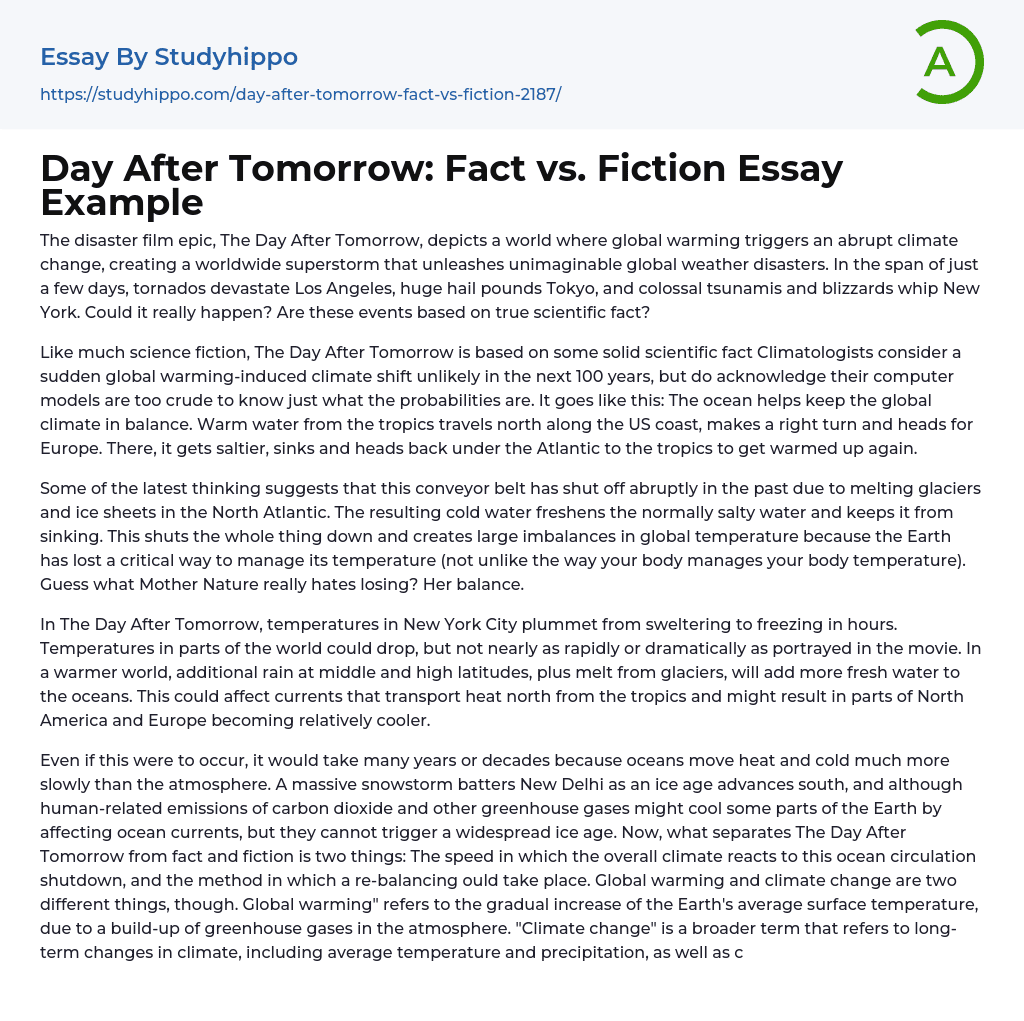The disaster film epic, The Day After Tomorrow, depicts a world where global warming triggers an abrupt climate change, creating a worldwide superstorm that unleashes unimaginable global weather disasters. In the span of just a few days, tornados devastate Los Angeles, huge hail pounds Tokyo, and colossal tsunamis and blizzards whip New York. Could it really happen? Are these events based on true scientific fact?
Like much science fiction, The Day After Tomorrow is based on some solid scientific fact Climatologists consider a sudden global warming-induced climate shift unlikely in the next 100 years, but do acknowledge their computer models are too crude to know just what the probabilities are. It goes like this: The ocean helps keep the global climate in balance. Warm water from the tropics travels north along the US coast, ma
...kes a right turn and heads for Europe. There, it gets saltier, sinks and heads back under the Atlantic to the tropics to get warmed up again.
Some of the latest thinking suggests that this conveyor belt has shut off abruptly in the past due to melting glaciers and ice sheets in the North Atlantic. The resulting cold water freshens the normally salty water and keeps it from sinking. This shuts the whole thing down and creates large imbalances in global temperature because the Earth has lost a critical way to manage its temperature (not unlike the way your body manages your body temperature). Guess what Mother Nature really hates losing? Her balance.
In The Day After Tomorrow, temperatures in New York City plummet from sweltering to freezing in hours. Temperatures in parts of the world could drop, but not nearly as rapidly o
dramatically as portrayed in the movie. In a warmer world, additional rain at middle and high latitudes, plus melt from glaciers, will add more fresh water to the oceans. This could affect currents that transport heat north from the tropics and might result in parts of North America and Europe becoming relatively cooler.
Even if this were to occur, it would take many years or decades because oceans move heat and cold much more slowly than the atmosphere. A massive snowstorm batters New Delhi as an ice age advances south, and although human-related emissions of carbon dioxide and other greenhouse gases might cool some parts of the Earth by affecting ocean currents, but they cannot trigger a widespread ice age. Now, what separates The Day After Tomorrow from fact and fiction is two things: The speed in which the overall climate reacts to this ocean circulation shutdown, and the method in which a re-balancing ould take place. Global warming and climate change are two different things, though. Global warming" refers to the gradual increase of the Earth's average surface temperature, due to a build-up of greenhouse gases in the atmosphere. "Climate change" is a broader term that refers to long-term changes in climate, including average temperature and precipitation, as well as changes in the seasonal or geographic variability of temperature and precipitation.
Global temperatures have increased over the past hundred years. Global warming is expected to increase ocean temperatures and to increase the flow of freshwater into the ocean through precipitation, run-off, and melting of glaciers. Even under the most optimistic circumstances, atmospheric scientists expect global climate change to result in increased flooding and droughts, more severe
storms, and a loss of plant and animal species. These events will occur, even if climate change is gradual.
There are a few ways to help the environment though. Technologies that reduce emissions and technologies that remove carbon from the atmosphere may all play a role. Government policies that encourage businesses to develop and use these and other technologies are also very important. This brings me to my final thought. It is clear that there is a lot that we do not know about how the Earth behaves when it gets toasty. The last time it warmed up before civilization existed.
Many say that because we do not what’s going to happen and that we do not need to take any kind of action today. The fact is though, it’s like the whole world is playing a high school science experiment with the Earth’s climate, and not everyone has their safety goggles on. From past experiences and knowledge of conducting experiments in Chemistry was that you always need to run a control experiment so you can measure the difference. The reality for humanity is, we’ve only got one Earth to tinker with, not two!
- Travel essays
- Asia essays
- Caribbean essays
- Developing Country essays
- America essays
- City essays
- Africa essays
- Australia essays
- Europe essays
- Georgia essays
- Middle East essays
- New Zealand essays
- South Korea essays
- Thailand essays
- Afghanistan essays
- Dubai essays
- North Korea essays
- Natural Disaster essays
- Earthquake essays
- Fracking essays
- Mountains essays
- Restaurant essays
- Hospitality essays
- Business Travel essays
- Hotels essays
- Tourism essays
- World Tourism Organization essays
- Kids travel essays
- Travel Agency essays
- ecotourism essays
- Air Travel essays
- Sea Travel essays
- Cathedral essays
- Traveling essays
- Fast Food Restaurant essays
- Motel essays
- Cultural Tourism essays
- The real essays
- Airlines essays
- Airports essays
- Boeing essays
- Low-Cost Carrier essays
- Easyjet essays
- Bangladesh essays
- Kuala Lumpur essays
- Malaysia essays
- Manila essays
- Philippines essays
- Singapore essays
- Vietnam essays




